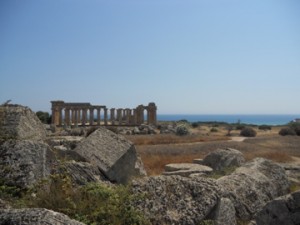Sicily Thus Far
On Monday, we took a flight from Rome to Palermo, Sicily. It lasted about an hour, which was much shorter than the initial flight to Rome. We arrived at out hotel and were given time to explore. Unfortunately, Internet in the hotel was rather expensive. The view in Palermo is amazing. We are surrounded by both water and mountains at the same time. Our view from the roof (which is the location of the hotel’s pool) is absolutely stunning, no matter what direction you turn. We ended the day with a three-course meal courtesy of the hotel. The food was incredible and was one of the first times the group had all been in one place for purposes other than class or touring.
On Tuesday, we took a bus from Palermo to the nearby town of Monreale. Here we visited the Monreale Cathedral, which was fascinating as it was influenced by Greek, Byzantine, and Moorish architecture. We explored the town further too, visiting street shops and vendors along the way. Monreale, like Palermo, has a beautiful view of the mountains and the water.
On Wednesday, we began the journey from Palermo to Agrigento, another city in Sicily. Along the way, we stopped at two Greek archaeological sites: Segesta and Selinunte. At Segesta, we examined the famous temple and theatre. The view out of the theatre, as in most of Sicily, was amazing. We followed Segesta with Selinunte, where we examined three temples (named E, F, and G) and the acropolis. Temples F and G were actually no longer standing, but we were able to climb on them. Climbing the ruins of the temples was absolutely amazing, as we were able to hop from rock to rock on material that once made up a classical Greek temple. The acropolis was also interesting, as we were able to see the general layout of the city through its ruins. For instance, we could see steps leading up to where a doorway would have been, and there is a space in the ruins for a door. After Selinunte, the bus continued to the city of Agrigento, which we able to explore throughout the afternoon and into the evening.
On Thursday, the professors took us to the site of the Valle Dei Templi in Agrigento, where we saw four temples (one dedicated to Juno Lacinia, one to Heracles, one to Zeus Olympic, and one called the Concord Temple, which is unknown to whom it was dedicated). The Juno and Concord temples were still standing, whereas the Heracles and gigantic Zeus temples were not. When the Zeus Olympic Temple was still standing, it was surrounded by giant telamons, or atlases, that appeared to be holding up the temple. Then we headed over to the Agrigento archaeological museum, where we were able to see artifacts that were uncovered along the sites of the temples. The museum was fascinating, as so many wonderful items had been found which help give us insight into the minds of people who lived a few thousand years ago. When we were done with our on-site lectures, the bus dropped us off in the center of town for more exploration of the area. The town is stunning, and seems to be made of a number of hilly, curving roads that lead into the center.
On Friday, we left Agrigento by bus and arrived in Syracuse (Siracusa) in the evening. Along the way we made two stops. One in a town called Caltagirone, a town known for its ceramics and pottery. We were able to visit a shop where were witnessed some locals molding and decorating some plates and figurines. It was interesting to watch exactly how these ceramic materials are created, and walking around the small town for a few hours was fun. Then we headed to a more classical site, the Piazza Armerina. This is a 3rd-4th century late Roman villa, known for its mosaics. Unfortunately, most of the Piazza was closed off for renovations, and was therefore off-limits to the public. The mosaics I was able to see were absolutely fascinating, but I wish I were able to see the entire Piazza. The bus set off again, and we finally arrived in Syracuse after a long day on the bus.
Today I got free Internet. Also, we explored the area of Siracusa with our three professors. We started the day by exploring the archaeological region about 15 minutes away from our hotel by bus (Parco Archeologico della Neapolis). The sites were rather close to one another, and consisted of a gigantic Greek theatre, a Roman amphitheatre (which differs from a theatre because it is made up of two semicircles, rather than one in a theatre), and the so-called ‘Ear of Dionysius.’ The Ear of Dionysius is a stone quarry, where in ancient time prisoners were kept. Afterward, we traveled to another region of Siracusa, known as Ortygia. Here we were able to see more sites, including the Temple of Apollo, the Fountain of Arethusa, and a modern-day cathedral that was built on top of a former Temple of Athena. The fountain was based on the myth of Alpheus and the nymph Arethusa, and it was a beautiful area of water surrounded by ducks and papyri plants.
Tomorrow we set out for our final city in Sicily bright and early, the city of Taormina. Hopefully I will get Internet again soon!




